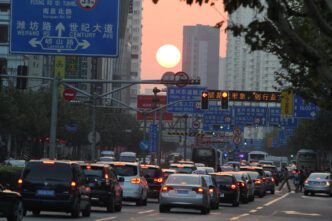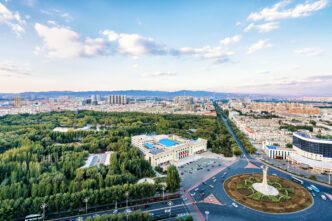Executive Summary
- China is pivotal in global climate change mitigation, despite being the largest emitter, by dramatically driving down the cost of green energy technologies like solar panels and electric vehicles through extensive industrial policies.
- China’s strategy of heavy subsidies and industrial focus has led to its dominance in global green energy production, now accounting for over 70% of worldwide electric car manufacturing and beginning to curb its domestic emissions.
- China is exporting vast quantities of affordable green technologies globally, especially to developing nations, making decarbonization economically viable, a role contrasted with potential impediments to U.S. climate efforts by a President Trump administration.
The Story So Far
- China, despite being the world’s largest greenhouse gas emitter, has strategically positioned itself as a pivotal force in global climate change mitigation by heavily subsidizing and scaling the production of green energy technologies like solar panels and electric vehicles. This industrial policy, integral to President Xi Jinping’s “new productive forces” initiative, has dramatically lowered global costs, making decarbonization economically viable for developing nations and establishing China’s dominance in exporting these essential technologies worldwide.
Why This Matters
- China’s extensive industrial policies and manufacturing prowess have critically driven down the cost of green energy technologies, making them economically viable for widespread global adoption, particularly in developing nations, thus positioning China as an indispensable, albeit complex, force in global climate change mitigation by enabling decarbonization without sacrificing economic growth; consequently, global climate goals are increasingly reliant on China’s continued production and export of these affordable technologies, even as this dominance creates a “Second China Shock” impacting other economies.
Who Thinks What?
- China, through its extensive industrial policies and manufacturing prowess, is significantly driving down the cost of green energy technologies globally, making them economically viable for widespread adoption and playing a pivotal role in climate change mitigation, a strategy supported by President Xi Jinping.
- Developing nations are adopting China’s affordable green energy technologies, such as solar panels and electric vehicles, primarily due to their cost-effectiveness compared to fossil fuel alternatives, enabling them to grow their economies without exacerbating climate change.
- The author contends that global climate goals cannot be met without China’s decarbonization and export of affordable green technologies, contrasting this with the U.S. Inflation Reduction Act’s modest global impact and potential impediments from the Republican Party and a future Trump administration to U.S. climate efforts.
China is increasingly positioned as a pivotal force in global climate change mitigation, according to a recent analysis, despite its status as the world’s largest emitter of greenhouse gases. The article highlights how Beijing’s extensive industrial policies and manufacturing prowess have dramatically driven down the cost of green energy technologies, such as solar panels and electric vehicles, making them economically viable for widespread adoption, particularly in the developing world.
China’s Environmental Footprint and Decarbonization Imperative
While China has made progress on some environmental issues, it remains the world’s largest single source of environmental harm, overfishing oceans and contributing significantly to atmospheric pollution. Its greenhouse gas emissions, primarily from coal use, surpass those of the United States and Europe combined, even after accounting for offshoring.
The analysis underscores that global climate goals cannot be met without China’s decarbonization. It argues that for developing nations to grow their economies without exacerbating climate change, they must replace fossil fuels with affordable green energy. This approach is favored over degrowth strategies, which are deemed unfeasible for these rapidly developing economies.
Strategy for Green Energy Dominance
The article suggests that significant cost reductions in green energy now stem primarily from scaling effects rather than solely scientific research. China has leveraged this by heavily subsidizing the production of solar cells, wind turbines, and, more recently, the electric vehicle industry.
President Xi Jinping has designated electric vehicles, batteries, and renewable energy as the “new three” at the core of China’s “new productive forces,” signaling continued government support for these technologies. This strategy is complemented by China’s established industrial strengths, including cheap bank loans, integrated supply chains, a vast pool of engineering talent, and wage suppression.
Global Market Impact and Emissions Trends
As a result of these efforts, China now dominates global solar panel production and accounts for over 70% of worldwide electric car manufacturing, with production continuing to rise significantly. Similar trends are observed in wind turbines and industrial electrification technologies.
Domestically, this scaling of green technologies is beginning to curb China’s emissions, with a plateau and even a slight reduction noted over the past year or two. Green energy is increasingly displacing coal in both electricity generation and industrial heating within the country.
Globally, China is exporting vast quantities of these affordable green technologies, particularly to developing countries in Africa, the Middle East, and Pakistan. These nations are adopting the technologies primarily due to their cost-effectiveness compared to fossil fuel alternatives, rather than solely for moral or self-preservation reasons.
Contrasting Approaches and Broader Implications
The author contends that while the U.S. Inflation Reduction Act was a positive step, its impact was modest and short-lived on a global scale. The analysis suggests that opposition to green energy from the Republican Party and potential actions by a President Trump administration and GOP Congress could further impede U.S. climate efforts, leading the U.S. to “abdicate” its leadership role.
Despite being a critic of the Chinese government, the author acknowledges China’s significant contribution to climate change mitigation through this strategy. The article also touches on the concept of the “Second China Shock,” recognizing that while heavily subsidized Chinese exports may pose a threat to domestic industries in many countries, they simultaneously play a crucial role in fighting climate change by making green technology universally accessible and affordable.








